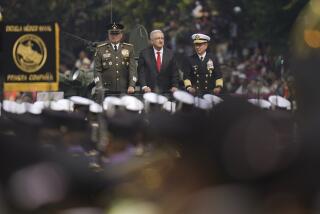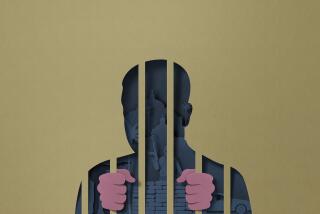Leaders of 5 Top ‘Families’ Charged : 2 New York Trials Expose Mafia’s Inner Workings
NEW YORK — It was after 11 p.m. at Snoopy’s Bar in Staten Island when three men burst in, declared that they were police officers and tried to drag big Jimmy McBratney through the door.
McBratney, a powerful man weighing more than 200 pounds, didn’t buy it. He fought back and was shot to death in the scuffle.
That was in May, 1973. On Thursday, a federal prosecutor identified one of the three phony cops as John Gotti, then an aspiring young hoodlum hoping to gain favor with his elders. Today, Gotti is 45 and the reputed boss of the largest organized crime group in the nation.
“John Gotti killed Jimmy McBratney out of ambition, out of ambition to advance in the Gambino crime family,” Assistant U.S. Attorney Diane Giacalone said at the opening of Gotti’s racketeering and conspiracy trial. “ . . . What is the lesson? In the Gambino crime family, killing is the way to climb the ladder of success.”
Now, with major mob trials under way at both ends of the Brooklyn Bridge, federal prosecutors are attacking and exposing the top leaders and inner workings of the Mafia’s billion-dollar business of murder, extortion, robbery and other crimes as never before. Law enforcement officials say the trials may be the most important assault on the mob since state troopers raided a national crime convention in rural Apalachin, N.Y., in 1957, sending 63 mobsters scurrying over fences and fields.
At the Gotti trial in Brooklyn and in a separate trial in lower Manhattan of six chiefs and two “soldiers” of the Mafia’s ruling “commission,” prosecutors for the first time are trying the reputed heads or leading members of the nation’s five largest and most powerful Mafia “families”--the Gambino, Genovese, Lucchese, Bonanno and Colombo crime groups.
Prosecutors are hammering the groups by relying on informants, on the bugging of homes, hide-outs and a mobster’s 1982 Jaguar, on photos taken secretly at mob weddings and wakes and on telephone wiretaps and other evidence to bolster their use of the 1970 Racketeer Influenced and Corrupt Organizations Act.
“What we’re talking about here is a crime business,” said Giacalone.
In a separate action in New Jersey Thursday, state police arrested 41 reputed mob members on gambling charges. Atty. Gen. W. Cary Richards said the arrests put “a major dent in the Genovese family” by putting out of business a $1 million-a-week gambling ring that operated a clandestine casino and $30,000 card games.
Even for longtime mob watchers, the New York trials already have produced several surprises. Chief among them was the admission for the first time by defense lawyers, during opening arguments in the so-called “commission trial” in Manhattan last week, that the Mafia indeed exists.
“This case is not about whether there is a Mafia,” said lead defense attorney Samuel Dawson, lawyer for Salvatore Santoro, the alleged “underboss” of the Lucchese crime group. “Assume it. Accept it. There is.” But Dawson said that just because someone is a “member of the Mafia” doesn’t mean he committed the crime alleged in the indictment.
First Prosecution Witness
The first prosecution witness was such a member. Angelo Lonardo, 75, a federally protected witness who is the highest-ranking mob defector ever to testify for the government, told jurors on Tuesday and Wednesday that he was an underboss in Cleveland for “the Mafia, La Famiglia, La Cosa Nostra,” until he was sentenced to life without parole plus 103 years in 1983 in a narcotics case.
Lonardo said two commission groups, one in New York and another in Chicago, set Mafia policy and oversee criminal operations. He identified Anthony (Fat Tony) Salerno, 75-year-old reputed head of the Genovese crime group, as a ranking member of the New York commission. Salerno glared at Lonardo as he spoke.
Lonardo testified that he had authorized several murders and had committed his first murder when he was 18, when he shot the man “responsible for killing my father” in a Cleveland mob war. Lonardo said he used his mother to draw his victim out of his hide-out.
Women Sometimes Play Role
Although it is frowned on by Mafia leaders, Lonardo said, women still sometimes play a role in mob affairs. In 1980, for example, he said, local soldiers murdered Philadelphia crime boss Angelo Bruno because their wives were envious of Bruno’s wife.
“All the soldiers’ wives were complaining,” he said. “They didn’t have nothing and she could write a check for $5 million.” Because other bosses had not sanctioned the hit, however, the killers “were condemned to death” by the commission, he added. More than 20 people were killed in the ensuing mob war.
In another apparent first for a mob trial, reputed Colombo crime boss and defendant Carmine Persico cross-examined Lonardo himself. Advised by a court-appointed lawyer, the rumpled, baggy-suited 53-year-old Persico is representing himself in the trial of the crime commission members.
“You’re in a hotel or motel. You’re eating pretty good?” Persico asked in his thick Brooklyn accent, grilling Lonardo about his being in the custody of U.S. marshals. “It’s fair,” Lonardo replied with a shrug.
In Brooklyn, at the federal trial against Gotti and six associates, another first is expected. Prosecutors say that a former soldier in Gotti’s group, Dominick Lofaro, 56, will testify that he made secret tape recordings of his meetings with Gotti for two years, using a tape recorder the size of two chewing gum packs hidden in the small of his back and operated with a switch in his cigarette lighter.
James Bond Tactics Hit
But Gotti’s lawyer, Bruce Cutler, dismissed such James Bond tactics--and denied the Mafia’s existence--in a fiery opening statement Thursday. He called prosecution witnesses “thieves, liars, murderers and scoundrels” and the Mafia “a fantasy-world business that doesn’t exist.”
Instead, Cutler pointed to a blackboard where prosecutor Giacalone had sketched out the Gambino group’s organization, with a “boss” at the top, followed by an “underboss” and “consigliere, “ and “crews” of “soldiers” headed by “capos.” Cutler compared it to the government law enforcement structure headed by the U.S. attorney general, the Justice Department, U.S. attorneys and police.
“As much as she says this thing is a business, that’s a business,” Cutler said. “They’re in the business of going after people they don’t like.” He added, “You can take this blackboard and you know what you can do with it.”
Cutler said Gotti’s “only family” is his wife, children and grandchildren. And the dingy red-brick Bergen Hunt and Fish Club in Ozone Park, Queens, that the prosecutor alleged is the headquarters where the Gambino group plans its crimes, is simply “John Gotti’s country club, if you will,” Cutler said.
Definition of ‘Godfather’
“You’re going to hear terms like ‘godfather,’ ” Cutler told the jury of the man whose brooding portrait is on Time magazine’s cover this week. “John Gotti is godfather to his friends’ children. There’s no crime to being godfather to your friends’ children.”
Sometimes shouting, sometimes whispering, Cutler repeatedly referred scornfully to prosecutor Giacalone as “the lady in red,” a reference to the red suit and ruffled white blouse that she wore. He called the indictment “rotten to the core,” “stinking,” “rancid” and “garbage” and slammed it into a wastepaper basket with a loud thunk.
Cutler told the jury that the charges against Gotti were “an indictment of his way of life” because of Gotti’s profanity-laced language on wiretap tapes and the $1,800 suits he reportedly wears.
“You see him there resplendent in his suit,” Cutler said, pointing at the grinning, carefully coiffed Gotti, who wore a dark-blue double-breasted suit with a neatly folded handkerchief in the top pocket. “It’s not being bold. It’s out of pride, the pride that made this country great.”
More to Read
Sign up for Essential California
The most important California stories and recommendations in your inbox every morning.
You may occasionally receive promotional content from the Los Angeles Times.











